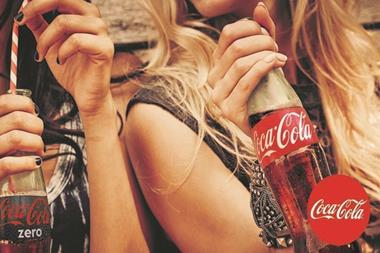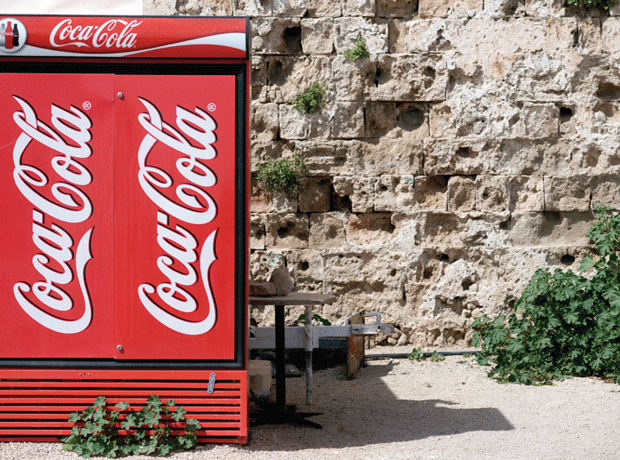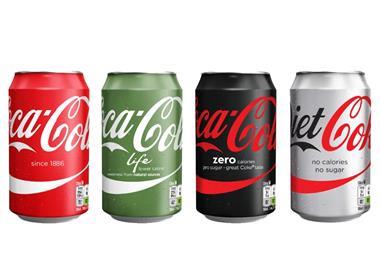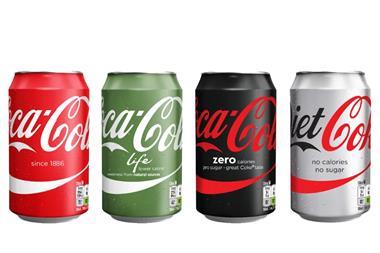
Coca-Cola has lost its fizz of late. With the war on sugar raging, the brand lost £30m in UK retail sales last year – as arch rival Pepsi enjoyed a boom driven by its sugar-free Pepsi Max.
Action was needed, and Coca-Cola GB today revealed a shake-up of its marketing and branding strategy that will bring the four sub-brands – Coca-Cola, Diet Coke, Coca-Cola Zero and Coca-Cola Life – under a single Coca-Cola brand. The plan is designed to raise the profile of Coke’s no and lower calorie products – and help consumers better understand their role.
It’s a good move; until I came to work at The Grocer, I was one of the 50% of UK consumers who don’t understand Coke Zero contains no sugar or calories. And it makes no sense to me to control one of the most powerful brands in the world – a brand that practically created Santa Claus – yet not make full use of its equity.
But I’m not a branding or marketing professional, so asked a bunch of people who are for their views on the significance – and possible effect – of the new strategy:
Sarah Green, MD, GreyShopper London
Coke is the archetypal masterbrand, so it seems extraordinary they’re only adopting this as a marketing strategy now. From Cadbury’s in the 90s, to our recent work with McVitie’s, we’ve seen the impact a masterbrand approach can have on a category and declining sales. It’s a proven way to rationalise a portfolio and marketing spend. But is this just another attempt to win back consumers in an increasingly health-conscious world?
Having a masterbrand strategy isn’t enough. Coca-Cola needs to address the core issue of relevance in a changing market, and give as much focus to the final 10 yards of the shopper journey as they do brand fame. While competitors have been single minded, ironically, Coke’s desire for ubiquity has been distracting and ultimately resulted in an erosion of its power.
Rob Metcalfe, MD, Richmond Towers
As one of the best-known and most heavily promoted brands in the world, Coca-Cola could be forgiven for thinking consumers know its range and sugar content market segmentation approach intimately. However, brands vastly over-estimate consumer interest in what they do and it’s not surprising there seems to be some confusion between the roles of the different Cokes in the range. Consumers I know seem to see Diet and Zero as pretty much interchangeable. This move certainly makes the choice clearer and it’s possible it will introduce some consumers to a Coke they didn’t know about. But it looks more like a re-packaging initiative than a major strategic shift. This development will have a minor positive effect on sales, simply because the packs look better than before. We’ve yet to see the creative tasked with turning that into significant growth.
Nir Wegrzyn, CEO, BrandOpus London
This is a classic example of confusion between brands, communications and packaging. Communication strategy cannot work if the branding works differently - they need to be in sync. A master brand cannot be created through communications alone; even if the advert features all the packs in the portfolio together.
For Coca-Cola to become a master brand it needs a single visual identity along with descriptive naming. A master brand cannot be achieved if the sub-brand names are retained, even if they are significantly decreased in size on the cans and bottles. It is clear Coca-Cola is concerned that fully adopting a master brand strategy on packaging may lead to a loss of recognition for variant names that the consumer is currently familiar with. Diet Coke is the elephant in the room here. A true master brand strategy requires a fundamental break in the current brand design code, and Diet Coke should adopt the Coca-Cola brand name.
Coca-Cola’s shift to creating a master brand is a great idea. What has been revealed so far is an executional aesthetic change, rather than a strategic brand redesign. But perhaps this design is a transition to a bigger vision. I hope so.
Paul Williams, Creative Director, Springetts
While the redesign and orientation change of the branding works, apart from the addition of the variant descriptors it feels more evolutionary than revolutionary. Having said that, the design works well across the shelf with all the variants now tessellating and the ribbon device and brand marks connecting.
My feeling is that it would have been a more confident and radical move to change the naming to Coca Cola, Diet Coke, Coke Zero and Coke Life. The individual communications as to why you would choose between the four is still unclear to me. ‘Zero calorie’s to ‘no calories’ to ‘lower calories’ are still confusing.
Don Williams, chief creative officer, pi global
Coca-Cola is one of those brands that was born with a one-product portfolio and what tends to happen with brands like this is that, rather than a grand strategy for branding and visual architecture from day one, it has slowly evolved with new variants being added, seemingly without any real solid framework or forethought for the future. Consequently, unfortunately and inevitably this causes confusion - whenever branding is used for variant signposting the equity becomes diluted.
Ask a consumer what the Coca- Cola visual equities are and as time goes and more and more variants proliferate, the answers may become a little woolly – is Coca-Cola one brand or is it four? Is it a red, silver, black or even green brand? This strategy may be entirely deliberate but I’m not convinced.



















1 Readers' comment